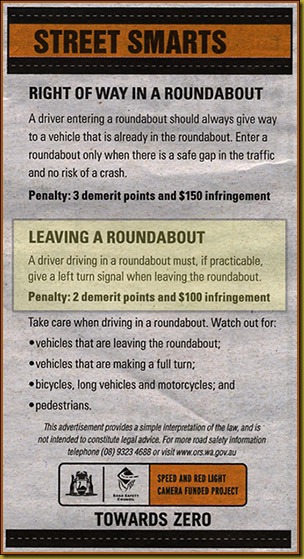Peeve: Vehicles (People) Not Indicating OFF a Round-a-bout
The following is really for readers in Western Australia (in Australia). International readers (assuming I have any) may want to skip this post. Although, having said that, it is a darned interesting read if there is nothing at all to watch on TV and you have run out of Web sites to trawl through.
First off let me make this point: The whole idea of traffic round-a-bouts is to keep the traffic moving.
They are generally installed at the intersection of roads of roughly equal priority to allow the removal of, or avoid the installation of, what is referred to as duelling Give-way or STOP signs.
The purpose of replacing Give-way or STOP signs with a round-a-bout is to remove the restrictions to the flow of traffic.
This would probably work if Perth drivers were better skilled at using round-a-bouts.
There are two common mistakes that drivers are making that basically destroy the primary reason for putting in a traffic round-a-bout.
Firstly, when approaching a round-a-bout, a lot of drivers come to an almost stop, or a complete stop, when there is no other vehicle on the round-a-bout at, or past, the last entry point to the right that they needed to give way to. When entering a round-a-bout you only have to give way to traffic entering the round-a-bout at the last entry point on the right, or to traffic already on the round-a-bout that is at or past the last entry point on the right.
Secondly, and this is the big one, this is my real peeve, most drivers do not indicate when they are about to exit the round-a-bout. This causes traffic that is starting to enter the round-a-bout to stop when they should not have needed to. But to the vehicle about to enter the round-a-bout it appears as if the car that is on the round-a-bout is actually going to continue on, hence they give way—only to then realise that the oncoming car is actually exiting and they did not need to give way.
This scenario can be even more exasperating when the oncoming car is actually still indicating around the round-a-bout, and then it exits instead—with its right indicator still ticking away.
In both cases the vehicle coming onto the round-a-bout has stopped and hence the traffic flow has been interrupted when it need not have been. The primary purpose of the round-a-bout has failed.
While there is no traffic penalty for not indicating when you enter a round-a-bout—indicating onto the round-a-bout is basically a courtesy and not a requirement—there is a penalty for failing to indicate when you are about to exit a round-a-bout. As can be seen from the “Street Smarts” cutting from Saturday’s Western Australian newspaper the penalty for not indicating when exiting a round-a-bout is 2 demerit points and a $100 fine.


